Travel > Caribbean Islands
Caribbean Islands
Tropical Escapes in the Caribbean Islands
Picture yourself strolling along the sun-kissed shores, feeling the soft, warm sand between your toes as the turquoise waves gently caress the coast. The Caribbean Islands offer retirees a dreamlike haven, where vibrant cultures and breathtaking landscapes intertwine. If you're seeking an engaging and bewitching retirement, let's embark on an odyssey through these enchanting isles, each with its own unique allure. To have the best experience when visitng, it's important to note that the peak of the hurricane season in the Caribbean generally falls between August and October, so you may wish to avoid visitng during this time.
Antigua and Barbuda

Photo by Nicola / Adobe Stock |
Located among the Leeward Islands, lies Antigua and Barbuda, a serene haven renowned for water sports. Idyllic beaches beckon retirees to bask in natural beauty and dive into crystal-clear waters. Sailing enthusiasts find their paradise here, with endless horizons promising new adventures.
|
Best Time to Visit: December to April. During this time, the weather is dry and sunny, with average temperatures ranging from 75 to 85 degrees Fahrenheit. The water is also warm and clear, making it perfect for swimming, snorkeling, and diving.
If you're looking to avoid the crowds, you may want to consider visiting during May and June or September and October. During these times, the weather is still pleasant, but there are fewer tourists. |
Bahamas

Photo by Kendrick Major / Pexels | The Bahamas captivate with their awe-inspiring beauty, boasting pink sand beaches embraced by turquoise waters. Delight in vibrant shopping experiences along colorful streets, savoring the rich flavors of the Caribbean amidst lively music. The islands have a rich past, and were a notorious haven for swashbuckling pirates Blackbeard and Calico Jack Rackham. |
Best Time to Visit: December to April. During this time, the weather is dry and sunny, with average temperatures ranging from 75 to 85 degrees Fahrenheit. The water is also warm and clear, making it perfect for swimming, snorkeling, and diving.
If you're looking to avoid the crowds, you may want to consider visiting during the shoulder seasons, which are May and June or September and October. During these times, the weather is still pleasant, but there are fewer tourists.
|
Barbados
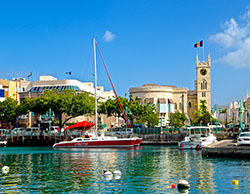
Photo by Kathryn Maingot / Unsplash | Barbados bears the distinctive mark of British charm and offers a wealth of picturesque beaches, luxurious resorts, and rejuvenating spas. Indulge in a game of golf on world-class courses, surrounded by lush landscapes and breathtaking ocean views. Take a moment to explore Harrison's Cave, a hidden gem nestled beneath the surface, where stalagmites and stalactites create a mesmerizing subterranean world. |
Best Time to Visit: During the dry season, which runs from December to April. During this time, the weather is sunny and warm, with average temperatures ranging from 75 to 85 degrees Fahrenheit. The humidity is also lower during this time, making it more comfortable to be outside.
If you're looking to avoid the crowds, you may want to consider visiting during the shoulder seasons, which are May and June or September and October. During these times, the weather is still pleasant, but there are fewer tourists.
|
Bermuda
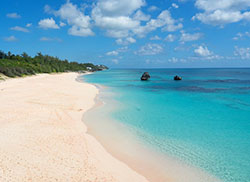
Photo by Larry White / Pixabay | In the North Atlantic Ocean lies Bermuda, a British territory boasting its own captivating brand of allure. Dig your toes into the warm iconic pink sand beaches and luxuriate in the cerulean waters that stretch out before you. Bermuda's charm extends beyond the shoreline, with its prestigious golf courses and vibrant nightlife. Revel in the rhythm of life as you dance the night away, or savor a peaceful moment as you stroll along the shore under the moonlight. |
| Best Time to Visit: during the spring (April to June) or fall (September to October) when the weather is pleasant and there are fewer tourists. The average temperature during these months is 75°F to 85°F. The summer months (July to August) can be hot and humid, and the winter months (December to March) can be rainy.
|
Curaçao

Photo by Simon Dannhauer / Adobe Stock | Curaçao, a vibrant Dutch island nestled within the Leeward Islands, presents a kaleidoscope of colorful buildings and a welcoming atmosphere. Immerse yourself in the island's vivacious nightlife, where laughter fills the air and melodies guide your steps. Curacao's charming locals embrace visitors as family, ensuring retirees feel at ease in this captivating Caribbean gem. |
Best Time to Visit: Curaçao is during the dry season, which runs from December to April. During this time, the weather is sunny and warm, with average temperatures ranging from 75 to 85 degrees Fahrenheit. The humidity is also lower during this time, making it more comfortable to be outside.
If you're looking to avoid the crowds, you may want to consider visiting during the shoulder seasons, which are May and June or September and October. During these times, the weather is still pleasant, but there are fewer tourists.
|
Dominica
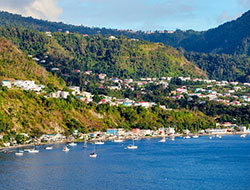
Photo by Richard Todd / Pixabay | Dominica, a haven of lush rainforests and cascading waterfalls, unveils its natural wonders to those who seek solace in nature's embrace. Retirees can embark on a journey of exploration, enjoy colorful cottages, traverse the verdant landscapes, breathe in the rejuvenating scent of the rainforest, and discover hidden treasures along the way. |
Best Time to Visit: during the dry season, which runs from December to April. During this time, the weather is sunny and warm, with average temperatures ranging from 75 to 85 degrees Fahrenheit. The humidity is also lower during this time, making it more comfortable to be outside.
Dominica is located in the hurricane belt, so there is a risk of hurricanes during the hurricane season (June-November). If you are planning to travel to Dominica during this time, be sure to check the hurricane forecast and be prepared to evacuate if necessary. |
Grenada
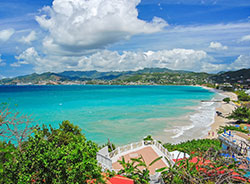
Photo by Pkazmierczak / Adobe Stock | Located in the Windward Islands, Grenada beckons retirees with its allure of beautiful beaches, sprawling nutmeg plantations, and the tantalizing aroma of spiced rum. Imagine lounging on the soft sands, soaking up the Caribbean sun, and surrendering to the tranquil rhythm of island life. Grenada's warm and welcoming atmosphere is sure to make retirees feel embraced by the island's gentle embrace. |
Best Time to Visit: During the dry season, which runs from December to April. During this time, the weather is sunny and warm, with average temperatures ranging from 25 to 32 degrees Celsius. The humidity is also lower during this time, making it more comfortable to be outside.
If you're looking to avoid the crowds, you may want to consider visiting during the shoulder seasons, which are May and June or September and October. During these times, the weather is still pleasant, but there are fewer tourists.
|
St. Lucia
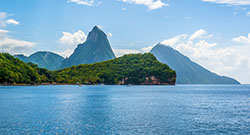
Photo by Nicola / Adobe Stock | A gem among the Windward Islands, St. Lucia reveals a symphony of volcanic landscapes, lush rainforests, and pristine beaches. The allure of this Caribbean paradise lies in its striking contrasts, where fiery mountains meet the tranquil sea, and nature's bounty is at every turn. Retirees can embrace the invigorating energy of St. Lucia as they traverse the scenic trails, surrendering to the captivating beauty that surrounds them. |
Best Time to Visit: December to April. During these months, the weather is typically drier with less rainfall and lower humidity. Additionally, this period aligns with the peak tourist season, offering a vibrant atmosphere and a variety of events and festivals. It's important to note that St. Lucia enjoys warm temperatures year-round.
The rainy season is typically from June to November. During this period, the island receives a higher amount of rainfall, and there is a higher chance of encountering tropical storms or hurricanes, particularly between August and October.
|
St. Vincent and the Grenadines
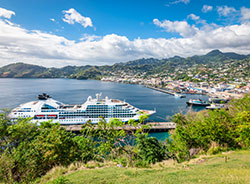
Nancy Pauwels / Adobe Stock | An archipelago within the Windward Islands, St. Vincent and the Grenadines invite retirees to indulge in the pure bliss of its breathtaking beaches, verdant rainforests, and the raw power of active volcanoes. Immerse yourself in the vibrant island culture, where smiles are abundant, and the scent of spices lingers in the air. St. Vincent and the Grenadines offer retirees a unique blend of tranquility and adventure, an enchanting tapestry to color their golden years. |
Best Time to Visit: December to May, this period is considered the dry season, characterized by lower rainfall and pleasant temperatures. The months of December to April are particularly popular among tourists, as they offer the most consistent and favorable weather conditions. During these months, you can expect warm temperatures, clear skies, and calm seas, making it an ideal time for beach activities, water sports, and exploring the stunning islands. It's important to note that St. Vincent and the Grenadines enjoy a tropical climate year-round, so even outside of the dry season, you can still have an enjoyable visit, although there may be a higher chance of encountering some rain showers.
Like many Caribbean islands, St. Vincent and the Grenadines are within the hurricane belt. The official hurricane season in the region runs from June 1st to November 30th. The peak period for hurricanes and tropical storms in St. Vincent and the Grenadines typically occurs between August and October.
|
Trinidad and Tobago
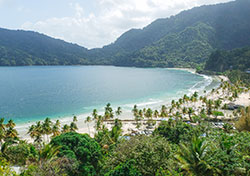
Photo by Thruston Benny / Unsplash | Nestled in the southern Caribbean Sea, Trinidad and Tobago offer a vibrant blend of cultures, stunning beaches, and lush rainforests. Lesser-known yet captivating is the phenomenon of bioluminescent organisms illuminating the pristine waters, adding a touch of magic to the islands' natural wonders. Adventurers can explore hidden rainforest corners and bask in the ethereal beauty of the coastline while experiencing nature's enchanting light show after dark. |
Best Time to Visit: The best time to visit Trinidad and Tobago in the Caribbean is generally from January to May. During these months, the islands experience a dry season with less rainfall and more consistent weather. The weather is typically warm and sunny, making it ideal for outdoor activities, beach visits, and exploring the vibrant culture and natural wonders of the islands.
Additionally, Trinidad and Tobago host their famous Carnival celebrations in February or March, which is a major highlight for visitors, showcasing colorful parades, lively music, and cultural festivities.
Their wet season is from June to December. It's worth noting that Trinidad and Tobago enjoy a tropical climate year-round, so even outside of the recommended period, you can still have an enjoyable visit, albeit with a higher chance of encountering some rain showers, tropical storms and hurricanes.
It's important to note that while hurricanes and severe storms can occur during August and October, they are not as common in Trinidad and Tobago compared to some other Caribbean islands. However, it's always advisable to stay informed about weather forecasts and follow any instructions or warnings issued by local authorities if you plan to visit during the rainy season.
|
Transportation:
The most popular way to get to the Caribbean is by plane. There are many direct flights from major cities in the United States and Canada. Once you arrive in the Caribbean, you can get around by car, taxi, bus, or ferry.
- If you are planning on doing a lot of exploring, it may be a good idea to rent a car.
- Taxis are a convenient way to get around, but they can be expensive.
- Buses are a cheap way to get around, but they can be crowded and slow.
- Ferries are a good way to get to smaller islands.
Safety Tips:
- Take out travel insurance.
- Be aware of the risks of crime and violence, especially in some tourist areas.
- Drink bottled water and avoid tap water.
- Be careful when swimming in the ocean, as there can be strong currents and rip tides.
- Take precautions against mosquito-borne diseases, such as Zika and dengue fever.
- If you are planning on doing any outdoor activities, such as hiking or biking, be sure to wear appropriate clothing and footwear.
- Travel Advisories Stay updated on current events, local regulations, and any travel advisories when traveling abroad. Visit the US Government State Department Travel Advisories web site to check on the status of your destination.
- Enroll in the STEP Program: Travelers are also urged to enroll in the U.S. State Department's Smart Traveler Enrollment Program (STEP) to receive security messages and to make it easier to locate them in an emergency. The Department uses these security messages to convey information about terrorist threats, security incidents, planned demonstrations, natural disasters, etc. In an emergency, please contact the nearest U.S. Embassy or consulate or call the following numbers: 1 (888) 407-4747 (toll-free in the United States and Canada) or 1 (202) 501-4444 from other countries.
| |
 Photo by Pkazmierczak
 Photo by BlueOrange Studio
 Photo by Pixabay
|
 Photo by Pkazmierczak
Photo by Pkazmierczak  Photo by BlueOrange Studio
Photo by BlueOrange Studio Photo by Pixabay
Photo by Pixabay